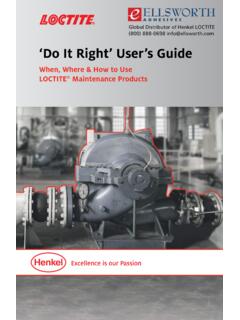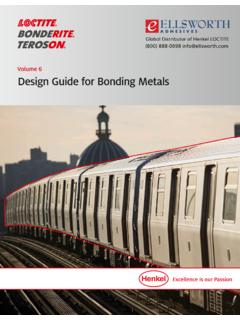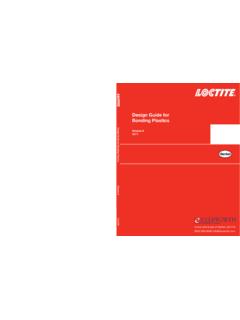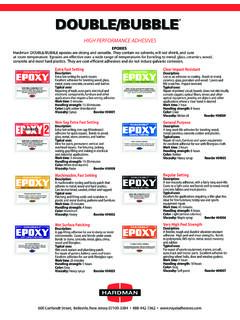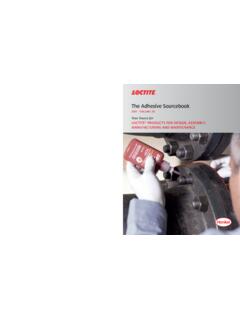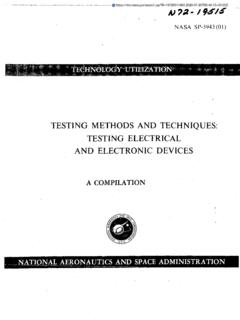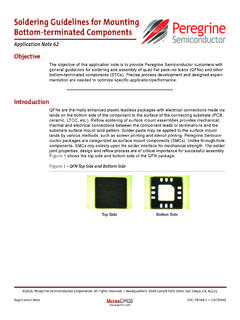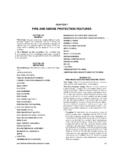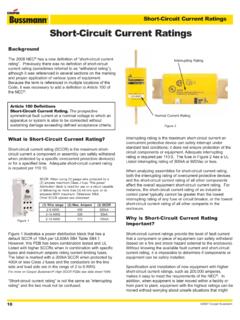Transcription of What You Need to Know to Ensure a Reliable Threaded …
1 Global Distributor of Henkel LOCTITE. (800) 888-0698 Threadlocking User's Guide What You Need to Know to Ensure a Reliable Threaded assembly 1 | Threadlocking User's Guide LOCTITE Threadlocking Guide CONTENTS. Threaded FASTENERS. Functions of a Threaded assembly 3. Why do Threaded assemblies fail? 3. LOCKING METHODS. Shortcomings of locking devices 4. Why use LOCTITE threadlockers? 4. LOCTITE THREADLOCKING SOLUTIONS. How does a LOCTITE threadlocker work? 5. How do I use a LOCTITE threadlocker? 5. When should I use a LOCTITE primer? 6. LOCTITE threadlocker key selection factors 6. HOW TO SELECT THE RIGHT LOCTITE THREADLOCKER. Decision tree 7. LOCTITE THREADLOCKING INNOVATIONS 9. LOCTITE THREADLOCKER PROPERTIES CHART 10. Visit for an all-access pass to distributors, MSDS, literature and product application assistance.
2 For your local LOCTITE Adhesives and Sealants Specialist, the nearest authorized LOCTITE products distributor, to place an order, to arrange an in-plant seminar or for technical product assistance, call ( ) in the , or call within Canada. Threadlocking User's Guide | 2. LOCTITE Finding a Better Way Old Way Better Way Mechanical Locking Devices LOCTITE Threadlockers Mechanical locking devices ( , split washers, nylon Invented 50 years ago by Loctite Corporation, now nuts) were invented to solve the common problem of Henkel Corporation, this revolutionary method to lock loosening that occurs in most Threaded assemblies. and seal Threaded fasteners with liquid anaerobic Although they were made for this purpose, they have adhesives has found worldwide acceptance.
3 Suited for several shortcomings. a wide range of applications, from delicate electronic components to heavy industrial equipment, LOCTITE . Shortcomings of Mechanical Locking Devices threadlockers have dramatically increased the Loosen under vibration, thermal expansion and/or reliability of Threaded assemblies. improper torque Do not seal threads Benefits of LOCTITE Threadlockers Lock nuts and bolts against vibration and Require extensive inventory of several shapes and sizes thermal expansion Prone to rust Seal against corrosion and leakage Reduce inventory costs Suitable for all shapes and sizes of fasteners Act as a thread lubricant Maintain critical adjustments of the assembly No on-torque adjustments needed High chemical resistance 3 | Threadlocking User's Guide Threaded FASTENERS.
4 Functions of a Threaded assembly 1. CREATE CLAMP FORCE. Clamp 2. MAINTAIN CLAMP FORCE Force 3. ALLOW DISASSEMBLY. Why do Threaded assemblies fail? Clamp force is not maintained Threaded assemblies loosen because of: A. Gaps: In order to make the assembly B. Vibration and side-to-side C. Expansion/contraction & loosening: possible, nuts and bolts must have some movement: These gaps allow the Expansion and contraction can also cause side-to-side tolerance, which creates gaps between parts to move from side-to-side movement. This, in addition to vibration, leads to the threads. when exposed to vibration. loosening and ultimately disassembly of parts. Parts tolerance. Vibration and loosening. Stretching of the bolt beyond its yield point and thermal expansion/.
5 Contraction of parts lead to lack of structural rigidity and relaxation of parts. Disassembly is not always possible This failure happens because, in certain conditions, a nut and a bolt can seize together. This seizing effect is caused by: Corrosion, rust, when dealing with: Humidity High temperatures assembly of different metals Corroded assemblies can be difficult to take ..which can lead to broken bolts. (galvanic corrosion). Galling (friction welding). Threadlocking User's Guide | 4. LOCKING METHODS. Shortcomings of locking devices Split ring or spring washers Tab washers, split pins, castle nuts Increased friction reduces clamp load; will Expensive and time-consuming methods, not Ensure Reliable threadlocking under they often impose challenges to line up dynamic loads.
6 Their components appropriately ( , tabs, cotter pins). Tooth or ribbed flanged bolts Nylon nut Prevent self-loosening, but are expensive; More expensive than a standard nut, nylon need larger flange-bearing surfaces and inserts increase friction, which results in may damage the surfaces. inaccurate torque. Why use LOCTITE threadlockers? LOCTITE Benefits Better Performance Cost Savings Reliable assembly : Lock against vibration, shock and Failure: Reliable Threaded assemblies thermal cycling plus seal against corrosion and galling. reduce costly downtimes. Easy disassembly using hand tools when low- or Inventory: One size fits all; universally applicable medium-grade formula is selected. for a wide range of fastener sizes. Outperform locking devices: Better clamp load Processing: Ease of automation reduces assembly retention compared to all mechanical locking devices.
7 Costs and increases throughput. Material Cost: Lower cost per unit compared to most locking devices. Vibration loosening test Cost per locking application Fastener Split LOCTITE . Size Ring Washer Threadlocker Standard bolt with LOCTITE threadlocker Clamp load in %. Bolt with saw-toothed flange 3/8" 2 2 . Nylon nut Bolt with DIN 6797 A tooth lock washer 5/8" 9 5 . Bolt with DIN 127 A split ring washer Unsecured standard bolt 7/8" 25 7 . Note: Washer pricing is based on 100 units purchased at an industrial distributor. LOCTITE pricing is based on the price of a 50 ml bottle and the number of drops required per application. Number of load cycles Note: Results from the Transverse Vibration Test ( Junkers Machine) that assesses fasteners' resistance to vibration loosening.
8 5 | Threadlocking User's Guide LOCTITE THREADLOCKING SOLUTIONS. How does a LOCTITE threadlocker work? Fill Gaps Seal Threads LOCTITE threadlockers are single-component adhesives that Another property of LOCTITE threadlockers is thread sealing. cure in the absence of air and in contact with active metal to This property is especially important when assembling form a tough thermoset plastic. They completely fill all voids through-bolts in an oil reservoir or cooling jacket in order to between the interfacing threads, which makes the assembly a keep the fluids sealed in and corrosion out. Examples of this unitized component and ultimately prevents loosening. application are common, but not limited, to gearboxes and internal combustion engines. Engagement area of rusty bolt that did NOT have LOCTITE.
9 Threadlocker applied. LOCTITE threadlocker between the interfacing threads. Engagement area of rusty bolt that DID have LOCTITE . threadlocker applied. How do I use a LOCTITE threadlocker? Application Options IMPORTANT: To achieve optimum performance, all parts must be clean and free of contaminants ( , oil, grease). For through-holes. For blind holes. For post- assembly . For overhead applications. For pre-applied applications. Dispensing Options For maximum convenience and productivity, LOCTITE threadlockers can be dispensed Push-close (. (. Pull-open through LOCTITE dispensing systems. For more information, visit 250 ml and 50 ml 250 ml and 50 ml LOCTITE LOCTITE integrated semiautomatic dispenser, push-pull nozzle. hand pumps. dispense valve and stationary dispense valve.))
10 Threadlocking User's Guide | 6. LOCTITE THREADLOCKING SOLUTIONS. When should I use a LOCTITE primer? Speed up cure Inactive metal assemblies*. Significantly speed up the cure time When assembling metal parts with inactive surfaces, of LOCTITE threadlockers when LOCTITE primers are recommended to Ensure proper performance assembling metal parts that are cold, of LOCTITE threadlockers. Not required for primerless products. have large gaps or deep threads. *Inactive Metals Active Metals (Primers Recommended) (Primers Optional). Plated Parts Zinc Magnetite Steel Iron Manganese Anodized Aluminum Pure Aluminum InconelTM Plain Steel MonelTM. Titanium Cadmium Silver Copper KovarTM. Stainless Steel Magnesium Gold Brass Galvanized Steel Natural or Chemical Bronze Black Oxide LOCTITE 7088 Primer Stick.
